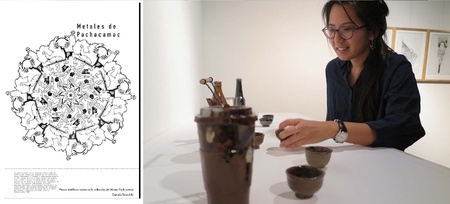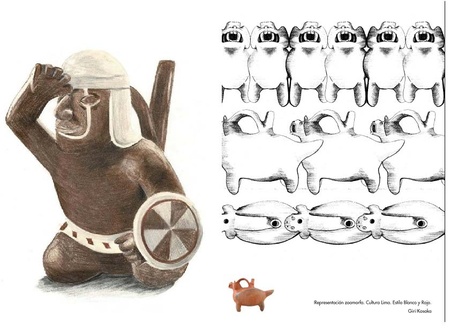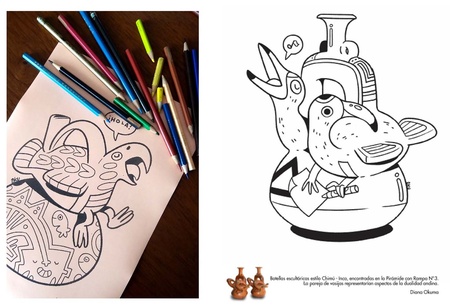Art always unites and, sometimes, surprises in complicated situations such as the quarantine that several countries are following, voluntarily or obligatorily, to stop coronavirus infections. In Peru, various institutions and companies are making efforts and innovations to stay connected with their audiences, and the Pachacamac Archaeological Site and Sanctuary Museum, founded in 1965 and belonging to the Ministry of Culture of Peru, is no exception.
Through digital tools such as videoconferences, virtual exhibitions and downloadable posters about their investigations in the sanctuary located on the central coast of the country, they try to keep alive this sanctuary made up of temples to which inhabitants of the Andes came in search of answers to some of their existential concerns since the Late Formative period (200 BC – 200 AD). On International Museum Day (May 18) this public institution presented its Coloring Book in a downloadable version .
Denise Pozzi-Escot, director of the Sitio Pachacamac Museum, explains in the introduction that this notebook compiles some of the educational activities developed by the museum team during the period of isolation due to the COVID-19 health emergency. “From this experience was born the idea of linking art, collaborative work and heritage as a way to remind ourselves of what we like to do, what we can learn and what we need to remember about our history.” The themes are iconography and imagery of Pachacamac, for which they have had the support of several Peruvian artists.
Nikkei artists
Daniela Tokashiki, Víctor Sakata, Ivet Salazar, Diana Okuma and Giri Kosaka are some of the Nikkei artists who participate in this notebook, which also brings together other renowned creators, such as Sheila Alvarado, Valentina Maggiolo and Diana Morillo, who have taken as reference some pieces from the museum's collections, recreating them in drawings with their personal styles, including mandalas.
“Illustration has always accompanied me, I like to make quick vignettes to visualize the ideas that go through my mind,” says Daniela Tokashiki , who studied industrial design in Lima and ceramics in Okinawa, but who always felt attracted to illustration. In 2017, she made illustrations for a children's activity booklet for the Pachacamac Museum that were based on pieces from the museum. “That year was the first time I visited the museum after its remodeling and I really liked it,” says Daniela, who contacted other artists to voluntarily participate in this new notebook.
“I think the museum's initiative in approaching the public using digital platforms is correct. I was surprised that you can take a virtual visit through the website, read reviews and access a large amount of information and photos,” says Daniela, who highlights that this project is a collaborative space with local artists with the same interests in Peruvian culture. “As artists, this type of project serves as inspiration for us to create work and also gives us greater visibility.”

salon artists
For some artists, this project has been an occasion to meet again with other artists who participated in the Nikkei Young Art Salon , a project started in 2017 in the Peruvian-Japanese Association that provided an exhibition space for new talents from this community. Víctor Sakata Gonzales is an industrial designer and participated in the notebook with illustrations about four ceramic pieces that he chose because they had in common being broken or cracked, in some cases with missing pieces.
“I feel that the mark of time is something that has always moved my imagination. I value these “scars” in the same way that kintsugi values them 1 . I tried to instill a dreamlike halo in these marks, so I used sinuous lines to graph them,” explains Víctor, whose favorite material is, precisely, ceramics.

Ivet Salazar Dias was part of the second edition of the Nikkei Young Art Salon and for this project she made some drawings based on a sculptural bottle that represents a shaman and some jugs.
“I have always been interested in the issue of identity, especially its recovery. I believe that any work that seeks to rescue the roots is very important,” says Ivet, whose Nikkei surname was left on the previous generation on her paternal side, and who He has dedicated himself to drawing, ceramics and textiles, the latter two in combined ways. His pieces, which he calls ceramic fabric, have been exhibited in various galleries and museums, such as the Qorikancha in Cusco and the Julio C. Tello in Paracas.

Art and union
Diana Okuma is an illustrator, author of the illustrated book Nikkei , and joined this project interested in the union of national heritage, art and teamwork. “I thought it was a very good proposal, since I could appreciate the pieces and interpret them in my style, something more informal and funny,” says Diana, who recreated the ceramic characters in a fun way, in order to give it a more friendly look for that children can enjoy them in this quarantine context.
“Communication and activities must not stop. Right now, many are looking to inform through digital platforms, I think this will help spread the cultural sector more in the future,” says Diana.
Giri Kosaka has dedicated himself to illustrating ancient Peruvian ceramics for several years and for this edition he has made drawings based on the Ychma jug and a zoomorphic representation of the Lima Culture.
“I think the work of the Pachacamac Museum is very important because they preserve our past to teach it to future generations. Culture is a human need, I believe that maintaining and preserving it depends on everyone. Peru has great representatives, I think there is a lack of more public incentives to show the talent that exists,” says Giri Kosaka, who studied Art, with a mention in Engraving, at the Pontifical Catholic University of Peru and who has participated in group exhibitions in Peru. Japan and Portugal.

Art and recognition
Víctor Sakata highlights the work of cultural entities during this situation. “Cultural activities save us from alienation. During this time, I have seen the emergence of many initiatives from dance, theater and audiovisuals, which, like this project, seek to continue sharing and contributing to happiness and health. mentality of citizens.”
Ivet Salazar says that she has seen “a lot of motivation on the part of some museums and social groups to give culture the recognition it deserves,” although there is still a need for policies that highlight the relationship between culture and our daily behavior, our social practices. "Interestingly, this situation has helped the sector to be appreciated a little more, since many times it has been the arts and culture that have kept us afloat in times of emotional crisis."
For Diana Okuma, perhaps organization is needed to show the events and activities of the sector. “Many are looking to inform through digital platforms, I think this will help spread the cultural sector more in the future.”
Giri Kosaka believes that, although artists are going through a bad time, it will be temporary. “Soon Peruvian talent will emerge with more strength, we have to resist,” he adds. In that sense, the artists say that they have seen many forms of social collaboration within the Nikkei community that stand out.

Nikkei collaboration
The Peru Ganbare campaign, to collect donations of food and masks for vulnerable areas and hospitals, organized by the Nikkei community, and support for the community's small businesses are part of the show of solidarity and collaboration of its members. “Every Nikkei is part of our family,” says Giri Kosaka. “The situation is not easy, but we must do our best and support as much as we can,” adds Diana Okuma.
“I think it is a good time to commit to development based on culture. In these times we all have the possibility of supporting from the simple act of consuming and disseminating,” says Ivet Salazar. For Victor Sakata, there are a large number of activities of the Nikkei community, such as radio taiso sessions, the virtual celebration of undokai and other activities show that the culture keeps the spirit of the community together, in which solidarity is rooted. “Since I was a child I have seen the support of these institutions and I continue to see it to this day. I feel that the ties of mutual support seen from the history of Japanese immigration to Peru remain intact and stronger,” he adds.
Other artists, such as the sculptor Carlos Runcie Tanaka , are participating in other initiatives, such as the proposal “ 200 artists for Peru ”, coordinated by Fietta Jarque Krebs, with the support of the Association of Curators of Peru and a group of volunteers, the which brings together the works of different Peruvian authors and whose proceeds will be used to support several hospitals in the country. It also includes the work of photographers Ike Ishikawa and Giancarlo Shibayama , and artists Arturo Kameya Yaga, Jorge Miyagui and Eliana Otta, Eduardo Tokeshi, among many others.
Note:
1. Japanese technique to fix ceramic fractures with different materials and that also reflects a philosophy of life.
© 2020 Javier García Wong-Kit







